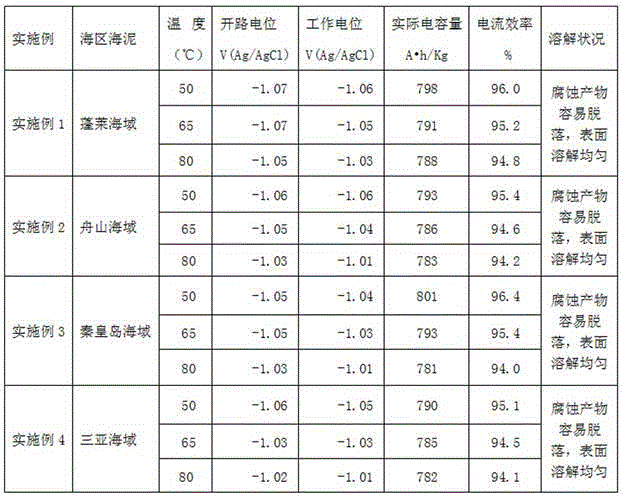Zinc alloy sacrificial anode applicable to hot seabed mud environment
A sacrificial anode and zinc alloy technology, which is applied in the field of marine equipment anti-corrosion, can solve the problems of low anode efficiency, achieve uniform dissolution of corrosion morphology, easy fall off, and reduce production costs
- Summary
- Abstract
- Description
- Claims
- Application Information
AI Technical Summary
Problems solved by technology
Method used
Image
Examples
Embodiment 1
[0012] Zinc alloy sacrificial anode formula (mass fraction): Al 0.15%, Mg 0.52%, In 0.028%, Ga 0.012%, of which impurity elements Fe 0.0015%, Pb 0.0038%, Cu 0.0008%, Cd 0.0015%, the balance is Zn .
[0013] Before smelting, preheat zinc ingots, zinc-aluminum alloys, and zinc-magnesium alloys to 100°C to remove moisture in the materials. Then heat the melting furnace to 450°C to completely melt the zinc ingot, add zinc-magnesium alloy (the mass fraction of magnesium is 46%) according to the formula ratio, cover the graphite layer above the zinc liquid to isolate the air, and use graphite artificially Rod stirring, stirring time 5 minutes. When the temperature of the zinc liquid rises to 480°C, add zinc-aluminum alloy (the mass fraction of aluminum is 12%) according to the formula ratio, and the stirring method is the same as above. When the temperature of the zinc liquid rises to 530°C, stop heating. Use a small crucible to scoop up the zinc liquid, wrap the indium ingot and...
Embodiment 2
[0015] Zinc alloy sacrificial anode formula (mass fraction): Al 0.38%, Mg 0.78%, In 0.017%, Ga 0.015%, of which impurity elements Fe 0.0012%, Pb 0.0035%, Cu 0.0005%, Cd 0.0012%, the balance is Zn .
[0016] Before smelting, preheat zinc ingots, zinc-aluminum alloys, and zinc-magnesium alloys to 100°C to remove moisture in the materials. Then heat the melting furnace to 430°C to completely melt the zinc ingot, add zinc-magnesium alloy (the mass fraction of magnesium is 50%) according to the formula ratio, cover the graphite layer above the zinc liquid to isolate the air, and use graphite artificially Stick stirring, stirring time 3 minutes. When the temperature of the zinc liquid rises to 470°C, add zinc-aluminum alloy (the mass fraction of aluminum is 8%) according to the formula ratio, and the stirring method is the same as above. When the temperature of the zinc liquid rises to 550°C, stop heating. Use a small crucible to scoop up the zinc liquid, wrap the indium ingot an...
Embodiment 3
[0018] Zinc alloy sacrificial anode formula (mass fraction): Al 0.23%, Mg 0.22%, In 0.011%, Ga 0.020%, of which impurity elements Fe 0.0018%, Pb 0.0028%, Cu 0.0009%, Cd 0.0019%, the balance is Zn .
[0019] Before smelting, preheat zinc ingots, zinc-aluminum alloys, and zinc-magnesium alloys to 100°C to remove moisture in the materials. Then heat the melting furnace to 450°C to completely melt the zinc ingot, add zinc-magnesium alloy (the mass fraction of magnesium is 41%) according to the formula ratio, cover the graphite layer above the zinc liquid to isolate the air, and use permanent magnets at the same time Stir, clockwise and counterclockwise for 3 minutes each. When the temperature of the zinc liquid rises to 470°C, add zinc-aluminum alloy (the mass fraction of aluminum is 15%) according to the formula ratio, and the stirring method is the same as above. When the temperature of the zinc liquid rises to 540°C, stop heating. Use a small crucible to scoop up the zinc li...
PUM
| Property | Measurement | Unit |
|---|---|---|
| melting point | aaaaa | aaaaa |
| melting point | aaaaa | aaaaa |
| melting point | aaaaa | aaaaa |
Abstract
Description
Claims
Application Information
 Login to View More
Login to View More - R&D
- Intellectual Property
- Life Sciences
- Materials
- Tech Scout
- Unparalleled Data Quality
- Higher Quality Content
- 60% Fewer Hallucinations
Browse by: Latest US Patents, China's latest patents, Technical Efficacy Thesaurus, Application Domain, Technology Topic, Popular Technical Reports.
© 2025 PatSnap. All rights reserved.Legal|Privacy policy|Modern Slavery Act Transparency Statement|Sitemap|About US| Contact US: help@patsnap.com

